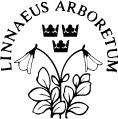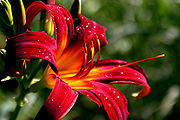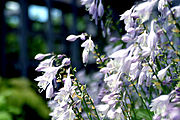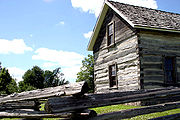
Linnaeus Arboretum
Encyclopedia

Gustavus Adolphus College
Gustavus Adolphus College is a private liberal arts college affiliated with the Evangelical Lutheran Church in America located in St. Peter, Minnesota, United States. A coeducational, four-year, residential institution, it was founded in 1862 by Swedish Americans. To this day the school is firmly...
in Saint Peter, Minnesota
St. Peter, Minnesota
St. Peter is a city in Nicollet County, Minnesota, United States. The population was 11,196 at the 2010 census. It is the county seat of Nicollet County.St...
, USA
United States
The United States of America is a federal constitutional republic comprising fifty states and a federal district...
, contains a number of botanical garden
Botanical garden
A botanical garden The terms botanic and botanical, and garden or gardens are used more-or-less interchangeably, although the word botanic is generally reserved for the earlier, more traditional gardens. is a well-tended area displaying a wide range of plants labelled with their botanical names...
s and an arboretum
Arboretum
An arboretum in a narrow sense is a collection of trees only. Related collections include a fruticetum , and a viticetum, a collection of vines. More commonly, today, an arboretum is a botanical garden containing living collections of woody plants intended at least partly for scientific study...
. The arboretum is named for Carolus Linnaeus
Carolus Linnaeus
Carl Linnaeus , also known after his ennoblement as , was a Swedish botanist, physician, and zoologist, who laid the foundations for the modern scheme of binomial nomenclature. He is known as the father of modern taxonomy, and is also considered one of the fathers of modern ecology...
, Swedish botanist. Its first trees were planted as small seedlings in 1973 on agricultural land.
History
Planning for the Gustavus Adolphus College Arboretum began in 1972. In January 1973, President Frank Barth announced the dedication of land lying west of campus for the purpose of developing an arboretum and wildlife area. Dr. Charles Mason, Associate Professor of Biology, oversaw the project. Project plans consisted of an initial fifty-five acres to be planted with grass and trees as well as an anticipated expansion to 130 acre (0.5260918 km²) if the project proved successful. In 1975, a master plan for the arboretum was developed which included three natural ecosystems and a formal garden, and Mason was appointed arboretum Director. The arboretum was home to more than 1,600 trees by 1978, and plans for the creation of two ponds were underway.In 1986, Borgeson cabin was moved to the arboretum from Norseland, MN, and the Melva Lind Interpretive Center was completed during 1987. The center includes office space for arboretum staff, interpretive educational exhibits, and a meeting space. In 1988, the arboretum was officially named the Linnaeus Arboretum after renowned Swedish botanist Carl Linnaeus. The Friends of the Linnaeus Arboretum formed during 1989; members of the group participate in volunteer and educational activities. Jim Gilbert became director of the Arboretum in 1998, and upon his retirement in 2005, the Jim Gilbert Teaching Pond was created. In 2003, the first Linnaeus Symposium was held in conjunction with the celebration of the Arboretum’s thirty year anniversary. The Symposium hosted renowned ethnobotanist Wade Davis.
Dr. Cindy Johnson-Groh became Executive Director of the Linnaeus Arboretum in 2006, and in 2007 the Johnson Center for Environmental Innovation was added to the Interpretive Center.
Layout
The arboretum was designed to represent the shape and ecosystem layout of the state of MinnesotaMinnesota
Minnesota is a U.S. state located in the Midwestern United States. The twelfth largest state of the U.S., it is the twenty-first most populous, with 5.3 million residents. Minnesota was carved out of the eastern half of the Minnesota Territory and admitted to the Union as the thirty-second state...
. Therefore, the three major natural ecosystems found in Minnesota are represented in the arboretum: the conifer forest in the north, the prairie
Prairie
Prairies are considered part of the temperate grasslands, savannas, and shrublands biome by ecologists, based on similar temperate climates, moderate rainfall, and grasses, herbs, and shrubs, rather than trees, as the dominant vegetation type...
in the south and west, and the deciduous
Deciduous
Deciduous means "falling off at maturity" or "tending to fall off", and is typically used in reference to trees or shrubs that lose their leaves seasonally, and to the shedding of other plant structures such as petals after flowering or fruit when ripe...
forest in between. A fourth area surrounding the Melva Lind Interpretive Center includes cultivated gardens and trees that were introduced into the state from other regions of the globe.
Gardens


- Thornberg Garden - Color from spring-flowering bulbs to chrysanthemumChrysanthemumChrysanthemums, often called mums or chrysanths, are of the genus constituting approximately 30 species of perennial flowering plants in the family Asteraceae which is native to Asia and northeastern Europe.-Etymology:...
s in the fall. - Greater Gustavus Hosta Garden - More than 20 varieties of hostaHostaHosta is a genus of about 23–45 species of lily-like plants in the family Asparagaceae, subfamily Agavoideae, native to northeast Asia. They have been placed in their own family, Hostaceae ; like many 'lilioid monocots', they were once classified in the Liliaceae...
plants. - Melva LindMelva LindMelva Lind graduated from the University of Minnesota with a Bachelor of Arts degree in 1923 and a Master of Arts degree in 1943. She then received the French equivalent to a Master of Arts degree from the Université de Lyon in Lyon, France in 1926. She went on to attend de L'Université de Paris...
Rose Garden - Nearly 50 roseRoseA rose is a woody perennial of the genus Rosa, within the family Rosaceae. There are over 100 species. They form a group of erect shrubs, and climbing or trailing plants, with stems that are often armed with sharp prickles. Flowers are large and showy, in colours ranging from white through yellows...
bushes selected from Canadian varieties. - Evelyn Gardens - Two gardens of perennial flowers, shrubs, and small trees.
- Swenson White Garden - White flowering annuals, perennials, and shrubs: dogwoodDogwoodThe genus Cornus is a group of about 30-60 species of woody plants in the family Cornaceae, commonly known as dogwoods. Most dogwoods are deciduous trees or shrubs, but a few species are nearly herbaceous perennial subshrubs, and a few of the woody species are evergreen...
s, viburnumViburnumViburnum is a genus of about 150–175 species of shrubs or small trees in the moschatel family, Adoxaceae. Its current classification is based on molecular phylogeny...
, potentillaPotentillaPotentilla is the genus of typical cinquefoils, containing about 500 species of annual, biennial and perennial herbs in the rose family Rosaceae. They are generally Holarctic in distribution, though some may even be found in montane biomes of the New Guinea Highlands...
, magnoliaMagnoliaMagnolia is a large genus of about 210 flowering plant species in the subfamily Magnolioideae of the family Magnoliaceae. It is named after French botanist Pierre Magnol....
, plumPlumA plum or gage is a stone fruit tree in the genus Prunus, subgenus Prunus. The subgenus is distinguished from other subgenera in the shoots having a terminal bud and solitary side buds , the flowers in groups of one to five together on short stems, and the fruit having a groove running down one...
, and mock orangeMock OrangeMock Orange typically means Philadelphus, a mostly Holarctic genus of shrubs. It can also refer to:* Bursaria spinosa , a small tree from Australia...
. - Thompson Herb Garden - Culinary, medicinal and fragrant herbHerbExcept in botanical usage, an herb is "any plant with leaves, seeds, or flowers used for flavoring, food, medicine, or perfume" or "a part of such a plant as used in cooking"...
s; herbs important to Native American cultures; and herbs with Biblical roots. - First Ladies' Lilac Walk - A collection of lilacLilacSyringa is a genus of about 20–25 species of flowering woody plants in the olive family , native to woodland and scrub from southeastern Europe to eastern Asia, and widely and commonly cultivated in temperate areas elsewhere....
bushes. - Presidents' Oak Grove - An oakOakAn oak is a tree or shrub in the genus Quercus , of which about 600 species exist. "Oak" may also appear in the names of species in related genera, notably Lithocarpus...
tree in honor of each president of the College. - Uhler Prairie - Grasses and flowers native to the drier areas of MinnesotaMinnesotaMinnesota is a U.S. state located in the Midwestern United States. The twelfth largest state of the U.S., it is the twenty-first most populous, with 5.3 million residents. Minnesota was carved out of the eastern half of the Minnesota Territory and admitted to the Union as the thirty-second state...
. - Johnson Prairie Outlook - A quiet place where one can sit on glacial boulders and observe the prairiePrairiePrairies are considered part of the temperate grasslands, savannas, and shrublands biome by ecologists, based on similar temperate climates, moderate rainfall, and grasses, herbs, and shrubs, rather than trees, as the dominant vegetation type...
. - Gamelin Linden Grove - Trees from both the Old World and the New World displaying variation within the genus TiliaTiliaTilia is a genus of about 30 species of trees native throughout most of the temperate Northern Hemisphere. The greatest species diversity is found in Asia, and the genus also occurs in Europe and eastern North America, but not western North America...
. - Esbjornson Ironwoods - Ironwood trees.
Other attractions
The arboretum also has a number of other attractions which are as follows:- Alexis Memorial Bluebird Trail - BluebirdBluebirdThe bluebirds are a group of medium-sized, mostly insectivorous or omnivorous birds in the genus Sialia of the thrush family . Bluebirds are one of the few thrush genera in the Americas. They have blue, or blue and red, plumage...
houses winding through the arboretum. Named for a longtime professor of English who was an avid birder.

- Borgeson Family Cabin - Built in 1866 by Swedish pioneers, the cabin was moved to the arboretum and restored in 1986. Adjacent to the cabin is a small vegetable garden that is planted annually with seeds that were stored from when the Swedish pioneers sailed across the ocean.
- Linnaeus Sculpture - Created by Paul T. GranlundPaul GranlundPaul T. Granlund was an American sculptor. His creative career spanned more than 50 years and more than 650 different works. Most of his work is figurative and made from bronze...
, sculptor-in-Residence at Gustavus Adolphus College. The bust grows out of a linden tree, and the wig includes impressions of the layout of the formal Linnaeus' Botanical GardenLinnaean GardenThe Linnaean Garden or Linnaeus' Garden is the oldest of the botanical gardens belonging to Uppsala University in Sweden. It has been restored and is kept as an 18th century botanical garden, according to the specifications of Carolus Linnaeus.The garden was originally planned and planted by Olaus...
in Uppsala, Sweden. Another copy was donated by the college to the Uppsala University Botanical Garden. - Meditation area - Designed using Chinese ElementsFive elementsFive elements may refer to: In philosophy: *Five elements *Mahabhuta*Pancha Tattva *Five elements In science:*Boron, element 5*Group 5 element*Period 5 element-See also:...
and feng shuiFeng shuiFeng shui ' is a Chinese system of geomancy believed to use the laws of both Heaven and Earth to help one improve life by receiving positive qi. The original designation for the discipline is Kan Yu ....
concepts to foster inspirational and intuitive introspection. Is used frequently as a space for yogaYogaYoga is a physical, mental, and spiritual discipline, originating in ancient India. The goal of yoga, or of the person practicing yoga, is the attainment of a state of perfect spiritual insight and tranquility while meditating on Supersoul...
and t'ai chi students. Created in 2004. - Melva LindMelva LindMelva Lind graduated from the University of Minnesota with a Bachelor of Arts degree in 1923 and a Master of Arts degree in 1943. She then received the French equivalent to a Master of Arts degree from the Université de Lyon in Lyon, France in 1926. She went on to attend de L'Université de Paris...
Interpretive Center - Exhibits and programs. Constructed in 1988. - Wetlands - A re-creation of similar areas that existed on this same land a little over a century ago, home to aquatic and semi-aquatic plant and animal species.

